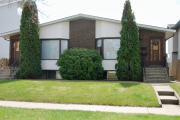The federal government kicked off its engagement on the Canada Green Buildings Strategy this summer and its report is expected to be released early this year. Currently, the building sector represents the third-largest source of emissions in Canada. The draft strategy sets a bold net-zero vision: To meet climate and affordability goals, most Canadian homes and buildings will need to be renovated to be more energy efficient and powered by clean energy.
Kick-starting a wave of deep retrofit renovations in Canada won’t be cheap: the federal government estimates an annual investment of $20 billion to $32 billion will be needed to retrofit most buildings by 2050.
While the investment is significant, so too will be the returns in the form of jobs and economic growth in the buildings sector. A renovation wave could generate more than $48 billion in economic development annually.
 In order to maximize these potential benefits, actions need to be taken to improve the design and administration of green building incentive programs at the federal, provincial and municipal levels to ensure they are realistic and align with what building and homeowners need to complete effective deep retrofits. There are a number of issues that, if left unaddressed, will put Canada at risk of fumbling this opportunity and failing to meet its net-zero commitments.
In order to maximize these potential benefits, actions need to be taken to improve the design and administration of green building incentive programs at the federal, provincial and municipal levels to ensure they are realistic and align with what building and homeowners need to complete effective deep retrofits. There are a number of issues that, if left unaddressed, will put Canada at risk of fumbling this opportunity and failing to meet its net-zero commitments.
Insufficient and complex funding programs
The maximum amount eligible per home under the Canada Greener Homes Grant is insufficient and needs to increase significantly to achieve real results. Right now, it’s capped at $5,000, which can be helpful for owners who are just trying to replace their furnace or change a few windows but is not enough to support the deep retrofits required to get homes to net-zero. Those can cost between $60,000 and $100,00 per home and to make deep retrofits accessible to all homeowners, the Greener Homes Grant should cover the full cost.
While businesses and homeowners can sometimes stack incentives offered by utilities, municipalities and provincial governments on top of the federal program to help them get there, the total grants are still too small compared to the cost of these projects, and meeting the individual program requirements adds to the complexity of the process.
Too much focus on heating systems, rather than energy efficiency
Incentive programs are also too narrowly focused on replacing inefficient heating systems with electric heat pumps, rather than addressing the efficiency of the entire home. Addressing energy efficiency should always start from the outside of the building — replacing insulation and airtightness first — then upgrading the heating and ventilation systems after optimal energy efficiency has been achieved. But that is not how most home and building owners approach building improvements.
As we approach the coldest winter months, we know that the impetus for most home upgrades will be emergency furnace replacements. With the right funding programs, it’s very likely we could incentivize owners to replace their broken furnace with a heat pump, but replacing insulation at the same time is not going to be a high priority when it’s -30 C — even if funding is available.
We need to meet homeowners where they are
The federal government should work with its municipal and provincial counterparts to advance four key changes to encourage greater collaboration between building industry players on deep retrofit projects and make it easier for homeowners to complete the retrofits they need on their timeline.
First, federal, provincial and utilities incentive programs should be structured to make the choice between furnaces and heat pumps an easy one when owners are confronted with the need to replace a heating system on short notice (and usually no budget). Incentives should be available to help owners quickly and easily get high-efficiency heat pumps at the same price or lower than a traditional furnace, as long as a plan is put in place to allow them to continue their journey to net-zero at a later date.
Second, we’d like to see the federal government support the integration of programs and funding by incentivizing building owners to create ‘net-zero plans’ to access retrofit funding. These would be customized, phased, multi-disciplinary renovation plans to decarbonize individual homes over time. Once the plan is created, accessing funding for each phase of the project would become quick and easy. And the closer the plan gets to net-zero, the bigger the incentives should be. That will also allow programs to meet homeowners wherever they are in their renovation journey.
Finally, while easy-to-access and stackable funding is a key priority, it’s also important that the programs encourage players within the building industry to collaborate on these phased and integrated deep retrofit plans. Right now, individual service providers like HVAC contractors, insulation specialists and window suppliers approach these projects separately, and we believe there is more benefit to our industries, the homeowners and our climate if we begin working on these projects together.
As builders and suppliers, we know that Canadians are ready for a renovation wave. We see the demand and significant economic opportunity every day. The federal government has an opportunity to create funding policies and programs that give owners not just the heat pumps they want, but empowers them to plan for the safe, healthy and affordable net-zero homes they and our climate desperately need.






